
We are living in a digital world. As a famous fictional alien group powered by technology might say: “Resistance is futile!” Like it or not, technology will continue to be an increasingly important aspect of running a modern business. The business leaders of today must embrace digital transformation if they’re going to stay competitive and make the most of the opportunities available to them.
But what exactly is digital transformation, and who should be responsible for taking charge of it in your company?
Quick Takeaways:
- Digital transformation is key to optimizing the customer experience for businesses today.
- Technology is a key part of digital transformation but not the only part. Real transformation means a culture shift, and it needs to come from the top.
- Your marketing team is best placed to understand the customer journey and the opportunities that come with going digital, and so your marketing department, led by your CMO, should be in charge of your overall transformation.
What Is Digital Transformation?
In its most basic terms, digital transformation is the process an organization goes through when it integrates digital technologies into its normal business processes.
The process of digital transformation looks different in every company, but in all cases, it means moving from analog to digital processes in order to operate more effectively and to serve their customers better. 4 out of 5 executives who have implemented digital transformation technologies say they are able to deliver better products and improved value.
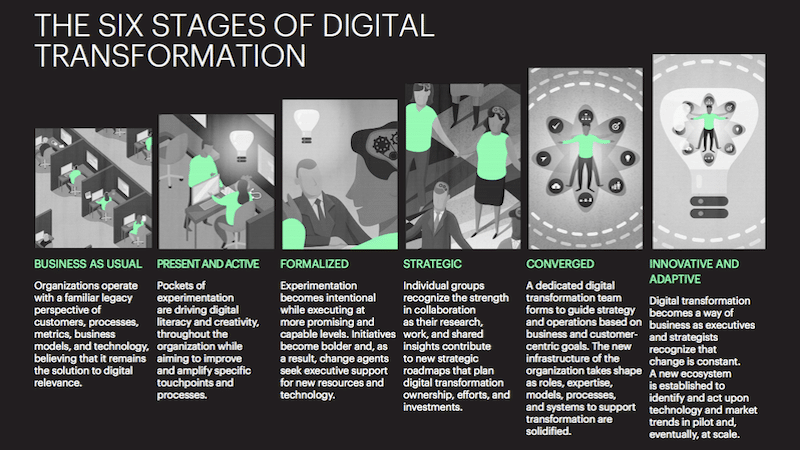
Digital transformation doesn’t just mean upgrading your legacy paper record system to a modern database, or “moving to the cloud” (although it may include both of these things.) Successful digital transformation demands a fundamental change in corporate culture, requiring employees at all levels to change their mindset. 87% of companies believe that digital will disrupt their industry, and 44% say they are ready to deal with those disruptions.
Businesses that have embraced digital transformation are more comfortable with risk and change, keen to abandon old, inefficient processes (even if they worked well in the past), and seek out new opportunities in order to grow and thrive.
Digital Transformation Isn’t Just About Technology
If your immediate thought is: “Technology? That’s a job to give to the IT department,” it’s time to shift your way of thinking.
Remember – digital transformation is not a superficial change. It’s not a case of simply installing some new software and being done with it. Real transformation means a fundamental change in how you do business, and this means that C-suite support is vital.
Getting buy-in from the director level is important for leading any transformation program, but what about the nuts and bolts of incorporating technology into your business on a practical level. Surely that’s the job of your IT support staff, right?
While it’s certainly true that your IT team will have a huge part to play in the overall success or failure of your digital transformation strategy, they shouldn’t have sole responsibility for choosing software solutions and re-working processes. It’s important to keep in mind that the ultimate aim of going digital for most businesses is to improve customer experiences.
Your employees who are experts in digital technology are most likely not experts in customer experiences. So don’t make the mistake of putting them in charge of these critical business decisions.
Why Marketers Should Drive Digital Transformation
So who does understand the customer journey in your company? For most businesses, the obvious answer to this is the marketing department. However, research shows that currently, CMOs are less likely to be involved in digital transformation than other members of the C-suite.
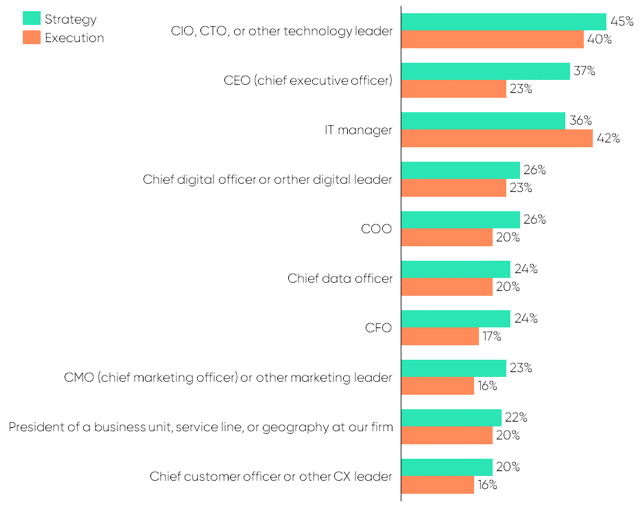
If your current digital transformation committee looks more like the above data, it may be time to shake up your strategy, and here’s why:
All business leaders know and understand that simply having a great product or offering valuable services isn’t enough. To achieve business success, you also need a comprehensive marketing strategy to raise awareness of your brand and product, engage with potential customers, and nurture relationships with your existing customers.
Marketers are no stranger to digital disruption. Advances in digital technology have transformed the world of marketing, perhaps more than any other industry.
In the span of a single generation, marketing has totally transformed from direct mail, print ads, and radio and television advertising to online content, email marketing, PPC, SEO, and a whole host of other brand new technologies and techniques that simply didn’t exist a few decades ago.
Most marketers didn’t see this brave new world of digital as a threat, but rather as a game-changer. The digital age has opened up countless doors and new opportunities when it comes to understanding your customers and crafting marketing messages to engage them.
And this evolutionary shift is not over yet. The digital world is rapidly changing, and your marketing department knows they have to respond quickly to these changes if they’re going to succeed.
What Is Marketing Transformation, Then?
Ivan Menezes, CEO of Diageo, put it well when he said, “It’s not about doing ‘digital marketing,’ it’s about marketing effectively in a digital world.”
A business digital transformation is the full and comprehensive leveraging of digital technologies, applied to every corner of a business’s operations. Marketing transformation entails not just existing technology, but also being flexible enough to evolve with future innovations.
For marketing teams, this involves all elements of the marketing process and centers on the customer experience.
Successful marketing teams have learned they need to take an integrated approach and plan their activities around the customer, not their internal processes. This means no more “website team” or “email team” or “social media team,” but rather a multi-disciplinary approach planned to get the most out of multi-channel marketing.
In marketing transformation, this breaking down of silos must be expanded out to the whole organization. Marketing becomes an important part of every employee’s role, whether they’re positioned in the sales department, HR, or customer service.
What Does Business Transformation Involve?
The typical B2B buyer performs approximately 12 online searches as research, according to Google. They also seek out content, consuming up to 13 pieces before purchase. This consists of vendor and third-party content.
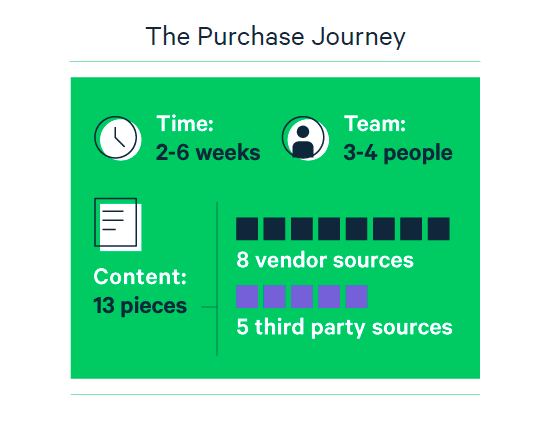
Meeting your customer where they are now requires robust digital channels. You need to attract their attention with content marketing efforts that demonstrate solutions, expertise, and thought leadership. Your content also needs to rank well to get found in those searches, which requires an investment in organic SEO.
Further, when a customer arrives at your website, it needs to be easy to navigate and find answers. You also need either an eCommerce framework to sell physical products or a self-guided experience for users so they can purchase your app or service.
A survey of 3600 SMBs found that 51% are accelerating digital transformation investments and priority. They also noted that the pandemic amplified this. The push to become more digital has value, and they know it.
The main drivers behind this rush to adopt include reducing costs, inspiring innovation, improving operations, boosting business growth, and improving productivity (see chart below):
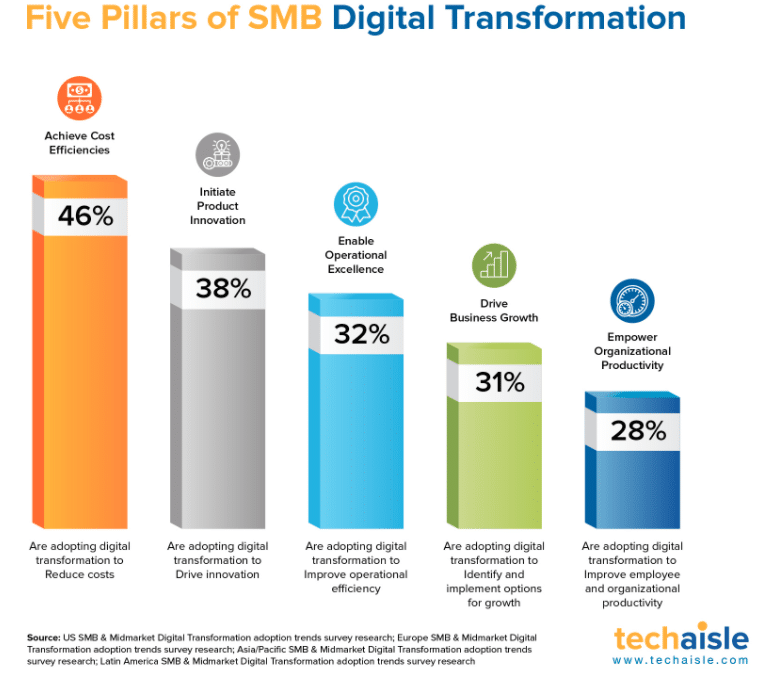
The good news is that these outcomes are not out of reach for B2B SMBs. There are specific strategies to implement that will accelerate or strengthen your digital transformation.
The Roadmap to Digital Transformation
Now, it’s time to talk about the roadmap and the pillars of business / digital / marketing transformation.
Recognize Behavioral Change — It Heralds Digital Transformation
Previous research by McKinsey has shown that less than a third of companies are successful in digital transformation. But now those same companies may now have no choice. “Innovate or die” has never been a truer statement for businesses in the coronavirus era.
Chances are, your business has had to make some adjustments during these challenging times. But have you dived headfirst into these challenges and embraced the opportunity to evolve? Or are you just doing the bare minimum to get by and waiting for the day when everything can return to normal?
If you’re in the second group, your business is missing out on a huge opportunity. And you may be in for a reality check if you think everything will return to normal once restrictions are lifted.
Change is often uncomfortable, and it’s natural to resist it. But just because something is hard doesn’t mean it’s not worthwhile.
If you’re struggling, here’s a rough guide to how digital transformation can help your business to not only survive but also thrive in the face of extreme challenges…
Adopt Customer-Centric Thinking
According to research published by Salesforce, 86 percent of senior-level marketers believe it’s critical to create a cohesive customer journey. When your marketing team establishes a true customer-centric approach, content marketing and the use of inbound marketing techniques naturally dictate your strategies.
While marketers have always considered customers’ needs and wants, the actual shift lies in how the relationship between brand and consumer is perceived. The idea is to move from telling customers what to think, to inviting them with value-driven content that improves their lives. As Moz writer Scott Wyden Kivowitz says, “Build relationships, not links.”
This is very different from traditional advertising that implies customer and brand as two opposing poles. Today, the businesses that have excelled at social media campaigns, vlogging, and optimized mobile websites have done so because they have merged the relationship. Consumers feel like the brands they love are genuinely relevant to their lives and are providing them something of value, from information and insights to inspiration and instruction — as well as the products and services they are selling.
Find the Right Technology Stack
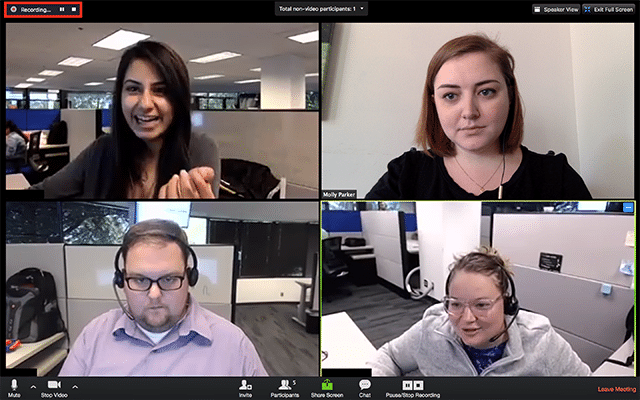
Digital transformation is about a lot more than just the software you use, but getting it right is essential.
With many businesses needing to move to a telecommuting model on short notice, there may not have been time to fully assess and review the options.
But if you feel you chose an option in haste that isn’t really working out for your company, it’s certainly not too late to change.
Don’t consider technology for remote communication and collaboration a temporary fix until you can get back into the office again. Instead, look for ways you can continue to use these technologies to improve productivity and provide more flexible working opportunities.
Consider this time your test period for experimentation. Take note of what’s working and what isn’t working. Try out a few different ways of communicating online and find out what seems to flow best for your company.
The key is to make technology your operating core. You probably already use a CRM solution and a couple of apps to help with automation. To step into tomorrow, marketing leaders are implementing digital technologies that let them do everything from one technology “stack”
- Search
- Lead generation
- Email marketing
- ROI measurement and analytics
- Website visitor tracking
- Landing page design and form builders
- Real-time sales data
- Social media marketing
This type of digital technology foundation allows you to connect all the dots of your marketing and see clearly the impact being made on revenue growth.
Invest in Digital Marketing
Many B2B SMBs use digital marketing to generate traffic and leads. However, they also traditionally spend a substantial amount on event marketing and sales travel. Those dollars are now available for other uses. Using them to invest in key areas of digital marketing will help audiences find and buy from you.
Here’s where you can put those dollars to reach digital transformation:
- MarTech tools as discussed above.
- Improving your digital channels, including adding eCommerce functionality or revamping your website. Website updates could involve virtual product tours, targeted personalization by visitor, and adding chatbots to answer questions fast.
- Content marketing: An investment in content marketing improves your organic ranking, which leads to more website traffic. Without buyers finding you online, you can’t sustain a digital ecosystem.
- Data science and advanced technology: If you want to master digital channels, you need to rely on things like artificial intelligence (AI) and machine learning (ML). AI and ML produce insights via data science, either autonomously or by actual data scientists. This valuable data can help you forecast and market better.
Putting budget dollars in these areas can lead to business growth and greater profitability. Spend wisely based on your digital transformation goals.
Empower Your Team
The next component of digital transformation is supporting your employees. For this process, the goal is to improve team productivity and agility. You’re asking them to adapt at record speed.
Many people dream of the opportunity to work from home, but reality rarely matches what they imagined, particularly at this point in time. Your employees are being forced to adapt to a completely new way of working, many in less-than-ideal circumstances.
Outdated hardware, unreliable internet connections, and balancing home and work life when nobody can actually leave that home are all common issues that individuals are dealing with at the moment.
Productivity is important, of course, but so is the well-being of your employees. And it may not be realistic to expect your employees to stick to the same work hours and tasks as they would do on a normal working day.
To ensure your team succeeds through this change, you must empower them.
There are two ways to do this. First, they need the right technology stack to communicate and collaborate, as well as to manage processes, grow, and scale. They won’t be able to reach the goals you set with disparate legacy systems.
Second, team members need to be part of the conversation. Cultural change is top-down, but it never works unless everyone’s on the same page. Openly communicate to your staff about the why, how, and what of digital transformation. It will provide them insight and offers transparency, which employees appreciate.
Embrace the Modern Customer Experience
B2B buyers aren’t new to the digital experience with brands. However, now you need to leverage digital tools to create experiences you can’t have face-to-face anymore. Bridging the gap here could produce some amazing innovations.
For example, you could host virtual events with your thought leaders, customers, or others in the field with a modern small business phone system. You could also employ virtual reality (VR) or augmented reality (AR) as a sales tool (check out the video below). Other smaller-scale options include video chats or adding new features to your app (if applicable) that resolve unique challenges.
Look for New Opportunities
While many businesses operating on a mostly digital model were affected only superficially by the pandemic, others have had to make significant changes in order to keep money coming in.
Restaurants have switched to taking online order and making deliveries, gyms are offering live online fitness classes over Zoom, and some bakeries have even started to offer bake-at-home bread kits to both meet the growing need for a therapeutic pastime and overcome the shortage of flour and yeast in many grocery stores.

Now is the time to look for ways that the internet and digital technologies can help you to pivot and expand your business.
Expand Your Customer Base and Build Trust Online
Small businesses serving customers face-to-face in their local area are the ones who have suffered most from lockdowns.
This is an excellent time to think big and expand beyond the limits of your local area.
Digital technologies make it possible for even the smallest companies to have a global reach. It may be time to start taking advantage of these opportunities and looking to market to a wider audience.
But this also means building trust. An independent coffee shop in a small-town builds trust by providing great service and friendly faces to its loyal customers, but this is not possible when switching to a business model that involves shipping bags of coffee nationally.
Instead, businesses operating online must build trust online through brand stories, thought leadership, content marketing and social media. If nobody knows who you are, your job is to help them get to know and trust you by communicating regularly, developing a strong brand presence, and publishing useful and entertaining content that will grow your authority and reputation.
Why Companies Struggle with Digital Transformation
Implementing a business-wide transformation is never easy. Not only does it take a lot of effort and resources to get through the process, it also requires the individuals that make up a team to be willing and committed to transform.
This means that everyone must see the value in a collective vision. This is easier said than done. With marketing, the need for an authentic and holistic digital transformation is more glaringly obvious than it may be for other business sectors — making it easier to inspire change. Still, there are serious obstacles that marketing leaders may face:
Getting the Necessary Budget
Problem one is convincing the C-suite to get on board. Upper management has to be just as interested in the results as your marketing team. The solution to this obstacle is to take the time to demonstrate need and to answer important questions to help managers feel comfortable with taking a big leap of faith. What are the short- and long-term plans? Over how long will the transformation process take place? How will this transformation help the company make money? What about training staff, hiring for new roles?
Addressing the Skills Gap
This is a major concern for many CMOs. There are so many new responsibilities and skills that need to be mastered in order to have an effective digital marketing team. Staff training and education, bringing in an outside digital marketing consultant, and hiring for new roles may all be on your agenda in order to get that stellar team that you need.
Staying Motivated
Your marketing team may have to take on new jobs, such as content creation, social media, and data analysis. If this wasn’t what they were originally hired for, how can you help them stay committed to their job and inspired to work for your company’s success? Checking in through one-on-one meetings can go a long way. This allows management a chance to further explain the need for transformation while also allowing employees to discuss their concerns. Regular short meetings — a core tenet of the agile, digital marketing culture you’re striving to create — can also help to keep everyone engaged, fired up, and focused on each project.
Getting Digital Transformation Right
Companies like Shop Direct, which had to evolve to respond to the consumer trend of moving from catalogue-based sales to digital, and pharmaceutical giant Astra Zeneca that used its partner scientists to create in-depth content, creatively operated through the new digital world with flying colors. Both companies were successful because they had gone through an entire process of change — they didn’t just come up with a new idea to plaster to their existing marketing. Shop Direct changed their entire sales model. Astra Zeneca created a new company website, became active on social media, and had to come up with an effective strategy to get busy scientists to see the value in creating digital content.
Successful digital transformation doesn’t happen overnight. It takes work and commitment. But, it also takes an understanding of how comprehensive the process is. It is only through having an evolved approach that is focused on the customer; supported and informed by an advanced, streamlined digital technology framework; and staffed by the right team — that your company can jump in this new digital ocean and navigate it with agility, vision, and success.
Technology is not the final solution to achieving business transformation, but only a tool to help you get there. By embracing digital methodologies, business models and opportunities, you can put your customers at the heart of your business transformation and let marketing lead the way.
When you’re re-working key business processes, it’s easy to be led by factors such as efficiency and cost savings, but don’t lose sight of the fact that your end goal is to provide the best possible customer service. Only by using marketing’s valuable insights, data, and commitment to innovation can you really achieve this.
Digital transformation is a process that never ends. New technology, market factors, and customer needs will keep reshaping the concept. Your focus should be on having intuitive tools, investing in digital marketing, supporting employees, and delivering exceptional customer experiences in the current environment.
If you are ready to get more traffic to your site with quality content published consistently, check out our Content Builder Service. Set up a quick consultation, and I’ll send you a free PDF version of my books. Get started today–and generate more traffic and leads for your business.
0 Commentaires